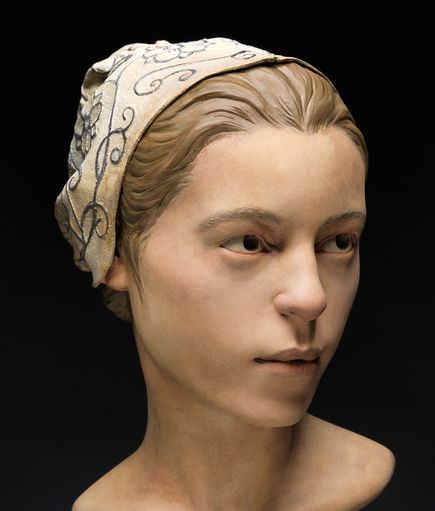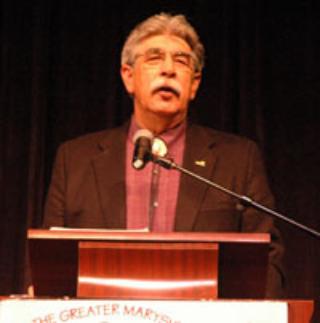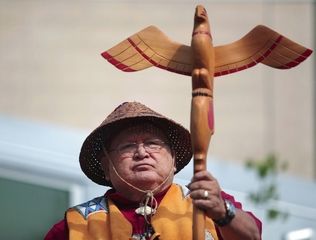Learn to make some great spring and summer floral arrangements with tips and training by our professionals at Salal.
Author: Kim Kalliber
McCoy will impart real-world perspectives in MPA program
Lawmaker, a long-time Native-American leader and economic-development/high-technology trailblazer, is named an adjunct professor at The Evergreen State College
Source: Office of State Rep. John McCoy
OLYMPIA — State Rep. John McCoy has already worn more hats in his personal and professional lives than about anyone else you could name. Don’t look now, but he’s about to don yet another impressive piece of headwear.
McCoy has accepted an opportunity to share his real-world knowledge and experience in the upcoming 2013-2014 academic year with students at The Evergreen State College (TESC). The veteran lawmaker, and Tulalip-tribal and Snohomish County community leader will teach as an adjunct professor in Evergreen’s Master of Public Administration (MPA) Tribal Concentration program.
“I am very honored and very grateful for this chance to work with men and women who are obviously very committed to lives of public service,” said McCoy. “I know that I will be learning every bit as much from them as I hope they will be learning from me.”
Lee Lyttle is Evergreen’s MPA Director and a faculty member. He said that TESC “is terrifically privileged to welcome and embrace in our college family a man possessed of Representative McCoy’s background and widespread acquaintance in ‘Indian Country’ issues and management.
“John McCoy’s ‘skill set’ in our 20th century and 21st century life and times is simply unmatched; there’s no other way, really, to put it,” Lyttle emphasized.
“The intersection of his diverse experiences in Indian Country — both in his pursuit of economic and community development and in his working with all levels of the business community and local, state and federal governments — will make Representative McCoy a singular, extraordinary participant in our program.”
McCoy represents the Everett, Marysville, and Tulalip communities and neighborhoods of Snohomish County in the House of Representatives. First elected to the Legislature a little more than 10 years ago, he now chairs the House Community Development, Housing & Tribal Affairs Committee. He is vice chair of the House Environment Committee, and he also has a seat on the House Education Committee.
McCoy served in the United States Air Force for 20 years, retiring in 1981 with extensive training in computer operations and programming. He worked as a computer technician in the White House from 1982 to 1985. Then he came back home to Tulalip, Snohomish County and the state of Washington. Very soon after returning home McCoy championed the bringing of computers, the Internet, and all that that entails to the Tulalip Tribes.
McCoy and his wife, Jeannie McCoy, make their home in Tulalip. They have three daughters, nine grandchildren, and one great-grandson.
The new professor will be visiting the TESC Tribal cohort on May 24. In the fall he will be teaching Tribal Economics and during the winter session he will be teaching Tribal Policy.
Lyttle said that McCoy’s classes will include as many as 30 MPA students, who themselves will bring a tremendous range of personal and professional knowledge to the academic table. Most but not all students in the program are Native American, and they come from different communities all across the land.
Evergreen’s MPA Tribal Concentration program right now represents the nation’s only such program placing strong emphasis on tribal-governance.
“With that in mind,” says the program website, “the Tribal Governance Concentration focuses on structures, processes and issues specific to tribal governments. It provides current and future tribal leaders with the knowledge and skills needed to work successfully in Indian Country. The Concentration is also appropriate for those working with governmental or other organizations in a liaison role with tribal governments. Students go through the entire program as a cohort and finish in two years in this structured program.”
Energy Department Announces $7 Million to Promote Clean Energy in Tribal Communities
Source: US Department of Energy
The Energy Department today announced up to $7 million to deploy clean energy projects in tribal communities, reducing reliance on fossil fuels and promoting economic development on tribal lands. The Energy Department’s Tribal Energy Program, in cooperation with the Office of Indian Energy, will help Native American communities, tribal energy resource development organizations, and tribal consortia to install community- or facility-scale clean energy projects.
Tribal lands comprise nearly 2% of U.S. land, but contain about 5% of the country’s renewable energy resources. With more than 9 million megawatts of potential installed renewable energy capacity on tribal lands, these communities are well positioned to capitalize on our domestic renewable energy resources—thereby enhancing U.S. energy security and protecting our air and water.
Through the “Community-Scale Clean Energy Projects in Indian Country” funding opportunity, the Energy Department will make up to $4.5 million available, subject to congressional appropriations, for projects installing clean energy systems that reduce fossil fuel use by at least 15% in either new or existing tribal buildings. Renewable energy systems for power generation only must be a minimum of 50 kilowatts and use commercial-warrantied equipment.
Through the “Tribal Renewable Energy and Energy Efficiency Deployment Assistance” funding opportunity, the Department will make up to $2.5 million available, subject to congressional appropriations, for projects installing renewable energy and energy efficiency that reduce fossil fuel use in existing tribal buildings by at least 30%. These projects must use commercial-warrantied equipment with renewable energy systems for power generation only of at least 10 kilowatts. Leveraging state or utility incentive programs is encouraged.
The full funding announcements are also available through the Department’s Tribal Energy Program website.
The Energy Department’s Office of Indian Energy and the Tribal Energy Program promote tribal energy sufficiency and foster economic development and employment on tribal lands through the development of renewable energy and energy efficiency technologies.
The Department has invested $41.8 million in 175 tribal clean energy projects over the years, and provides financial and technical assistance to tribes for the evaluation and development of their renewable energy resources, implementation of energy efficiency to reduce energy use, and education and training to help build the knowledge and skills essential for sustainable energy projects.
Key Thoughts From KeyBank: Financial Education Empowers Native Families
Source: Indian Country Today Media Network
A lack of resources to help Native Americans learn effective money management techniques has stunted the ability of many Native families to reach their full potential. But KeyBank is working to change that by expanding the delivery of financial education to Native communities across the country.
KeyBank, a leader in meeting the financial needs of Indian country, has launched a four-year financial literacy program coordinated by First Nations Oweesta Corporation, a wholly held subsidiary of First Nations Development Institute and the first certified national Native Community Development Financial Institution (CDFI) intermediary. The program, made possible by a $250,000 grant from KeyBank and KeyBank Foundation, teaches American Indians how to manage their money, save toward financial goals, take advantage of financial resources and avoid predatory lenders. “KeyBank Foundation focuses its grant making on financial literacy and diversity, which help to drive job success,” said Foundation chair Margot Copeland. “We’re proud to be a leader in supporting Native communities.”

The program, “Expanding Financial Literacy Efforts in Native Communities,” takes a unique approach to financial education called train-the-trainer. Oweesta professionals teach local Native CDFIs how to conduct financial literacy programs for their nations. “[Our] financial education programs contribute significantly to the development of sustainable Native economies and healthy communities,” said Chrystel Cornelius, Oweesta’s acting executive director.
KeyBank is dedicated to helping communities that are traditionally under-banked. Since July 2008, the company has extended more than $4 billion in financing to developments in underserved communities and granted more than $40 million to nonprofit organizations. More than 28,000 individuals have taken KeyBank’s free financial education classes since the inception of KeyBank Plus in 2004.
“Financial success in life depends on good financial education, and we are dedicated to supporting programs that help people of the First Nations thrive,” said Mike Lettig, director of Native American Financial Services for KeyBank. “KeyBank was one of the first financial institutions in the country to create teams focused exclusively on serving Native Americans. We understand the importance of each Nation’s laws, culture and governance, and we make sure our recommendations are aligned with tribal traditions and values.”
To learn how KeyBank can help your Nation succeed, visit key.com/nativeamerican.
All credit products are subject to credit approval. KeyBank is member FDIC.
Read more at http://indiancountrytodaymedianetwork.com/2013/05/01/key-thoughts-keybank-financial-education-empowers-native-families-149120
Survival Cannibalism Confirmed at Jamestown Settlement

This April 2013 photo shows a forensic facial reconstruction produced by StudioEIS of Brooklyn, New York in consultation with Smithsonian researcher based on human remains excavated in James Fort, Jamestown, Virginia.
Source: Indian Country Today Media Network
Suspicions of cannibalism at the Jamestown Settlement have been around for a long time. Those suspicions were confirmed May 1 when the Smithsonian Institution, Colonial Williamsburg and Preservation Virginia released findings from remains that that back to the harsh winter of 1609-1610, also called the “starving time.”
A portion of skull and tibia of a 14-year-old girl—named “Jane” by researchers—were found among dog and horse bones in 2012 during an excavation at James Fort.
“This discovery may confirm a number of 17th century references which describe the starving time and the desperation of the colonists and that some of them resorted to living off the people that died first,” said William Kelso, chief archaeologist with the Jamestown Rediscovery Project, in a press release.
Doug Owsley, the division head for physical anthropology at the Smithsonian’s National Museum of Natural History, detailed that four shallow chops to the forehead indicate an initial attempt to open the skull. He said the back of the head was also struck by a small hatchet or cleaver, and sharp cuts and puncture marks on the mandible show tissue was removed from the face and throat using a knife.
“The desperation and overwhelming circumstances faced by the James Fort colonists during the winter of 1609–1610 are reflected in the postmortem treatment of this girl’s body,” Owsley said in a press release. “The recovered bone fragments have unusually patterned cuts and chops that reflect tentativeness, trial and complete lack of experience in butchering animal remains. Nevertheless, the clear intent was to dismember the body, removing the brain and flesh from the face for consumption.”
Researchers believe the young girl was dead before she was consumed.
Jamestown was the first settlement of the Virginia Colony established in 1607. Stories of cannibalism, including one about a man killing, “salting” and eating his pregnant wife, are not new. The man was later executed.
James Loewen mentions it in Lies My Teacher Told Me: Everything Your American History Textbook Got Wrong when talking about why we ignore Jamestown. “Historians could hardly tout Virginia… The Virginians’ relations with the Indians were particularly unsavory… the early Virginians engaged in bickering, sloth, even cannibalism. They spent their early days digging random holes in the ground, haplessly looking for gold instead of planting crops. Soon they were starving and digging up putrid Indian corpses to eat or renting themselves out to Indian families as servants,” he wrote.
Read more at http://indiancountrytodaymedianetwork.com/2013/05/01/survival-cannibalism-confirmed-jamestown-settlement-149143
Sheldon presents ‘State of the Tribes’

Tulalip Tribal Chair Mel Sheldon Jr. speculated that the economy might be on its way back during this year’s State of the Tribes address to the Greater Marysville Tulalip Chamber of Commerce on April 26.
By Kirk Boxleitner, The Marysville Globe
TULALIP — Tulalip Tribal Chair Mel Sheldon Jr. expressed optimism for the future, both in the short term and the long run, as he delivered this year’s State of the Tribes address to the Greater Marysville Tulalip Chamber of Commerce on April 26.
“This was one of the strongest economic regions of the pre-Columbian era, and it can be so once again,” said Sheldon, citing the Native American tribes’ commerce in this area, even well before white settlers had ever arrived. “We offer gaming, retail and entertainment to visitors.”
Sheldon summed up the results of the recent Tulalip Tribal Board of Directors election by noting that he, Vice Chair Deborah Parker, Treasurer Chuck James and Board members Glen Gobin and Marlin Fryberg Jr. had all been reelected, while Marie Zackuse was elected back onto the Board as secretary, and Theresa Sheldon was elected to her first term on the Board.
“Deborah Parker has really led the charge on the Violence Against Women Act,” Sheldon said. “It’s a monumental achievement on behalf of Indian Country and all women.”
Sheldon also praised Ken Kettler, president and chief operating officer of the Tulalip Resort Hotel and Casino, for the roles that he and his staff have played in the Tulalip Resort’s host of awards over the past year, including being named “Best Casino of the Year” by KING-5.
“This place is a destination,” said Sheldon, who cited the number of organizations that take advantage of the hotel’s conference rooms. “We’re 100 percent occupied during the weekend and 80 percent occupied during the week. You can build something like the Taj Mahal casino, that people will visit once and then never again, or you can do what we did.”
While the Tulalip Resort is set to add Asian fusion cuisine and sports bar restaurants this summer, the Quil Ceda Creek Casino is due for $15 million worth of remodeling.
“There’s been rumors for a while that we might be adding a new hotel wing, and the truth is that we’re always having conversations about it,” Sheldon said. “If we’re at 80 percent of our total occupancy during the week, we could probably stand to expand.”
Although Sheldon praised the Tulalip Amphitheatre as an intimate outdoor venue for entertainment and various community events, he acknowledged that the Board has asked itself whether there should be a larger capacity events center as well. And with the Tribes meeting their budget projections, Sheldon speculated that the economy might be on its way back.
“Tulalip dollars stretch a long way,” Sheldon said. “Seventy percent of our work force lives off the reservation. We pay out $120 million in annual wages, and most of that money stays in the local economy. Last year, Quil Ceda Village paid $40 million in state sales tax.”
Sheldon touted the past year’s openings of Cabela’s and the Olive Garden, and anticipated the impending completion of 90,000 additional square feet to the Seattle Premium Outlets. At the same time, Sheldon was quick to share credit for the Tribes’ successes with its partners in the cities of Marysville and Everett, Snohomish County and beyond.
“Marysville’s got a great mayor whose work will benefit this community even long after he’s gone,” said Sheldon, who mentioned Marysville Mayor Jon Nehring’s lobbying against the traffic impacts of increased coal trains as but one example, before he directed his comments to outgoing Marysville School District Superintendent Dr. Larry Nyland. “From our hearts, we thank you. We’ve always trusted you. We’re blessed with great leaders all around. If we want a strong economy, we need to keep working together.”
Tulalip Tribes’ cultural director lived for preservation

Hank Gobin, museum director at the Hibulb Cultural Center, listens at the grand opening of the center in Tulalip.
By Bill Sheets, The Hreald
TULALIP — Hank Gobin lived to see his dream come true: the creation of a museum to serve as the focal point of local tribal history and culture.
Gobin, 71, cultural resources director for the Tulalip Tribes, passed away Thursday — a little more than 1½ years after the Hibulb Cultural Center was dedicated in August 2011.
While the museum may be the most tangible testament to his legacy, his role in preserving tribal culture runs much deeper, tribal members say.
“Our community mourns the loss of a truly great man,” Tulalip Chairman Mel Sheldon said in a written statement.
“He was a prolific artist, activist and traditional scholar, who worked in the areas of art, education, language revitalization, museum studies and traditional foods research.”
Gobin was a force in starting the tribes’ cultural resources program in the early 1990s. This included a program to teach Lushootseed, the Puget Sound tribes’ unwritten native language, to help save it from extinction.
“He was one of the key advocates who pushed for the creation of the Lushootseed program,” said Natosha Gobin, a language teacher for the Tulalips.
The language program has grown from its fledgling origins to a year-round course in Montessori school, along with kids camps in the summer and an annual eight-week workshop for families.
“He’s always been a huge advocate for cultural preservation and bringing it all together,” Natosha Gobin said.
Her father, the late Bernie Gobin, was Hank Gobin’s first cousin.
“It was a hard loss,” she said of Hank’s passing.
Henry Delano Gobin was born in 1941 and raised on the Tulalip reservation. He left at age 21 to pursue an education and studied art at several colleges in the West, including the Institute of American Indian Arts in Santa Fe, N.M. and the San Francisco Art Institute. He received a master’s degree in painting at Sacramento State University and later taught art and ethnic studies.
Gobin returned to Tulalip in 1989 and quickly began working on preserving tribal culture, including pushing for the museum. Finally, after a long haul, the tribal board in 2005 approved the building, which opened in 2011.
Gobin used his artistic talent and education to closely supervise the design of the cultural center. The day the $19 million building opened, Gobin recalled a conversation he’d had years earlier with the architects.
“One of the things I want you to do,” he told them, “is to capture the light.”
The 23,000-square-foot building’s main corridor is equipped with skylights. The museum houses traditional tribal cedar baskets, tools, clothing, canoes, totem poles and other items, some of them hundreds of years old. Many of the items had sat stored away in people’s homes on the reservation. Lectures and other programs are held at the cultural center as well.
The museum’s grounds at 6410 23rd Ave. NE are home to a native plant cultivation and harvest program in which young people learn traditional tribal culinary ways.
“I think it’s an exciting time for the Tulalip Tribes and Tulalip people,” Gobin said shortly before the museum’s opening.
Gobin also was instrumental in reviving the annual tribal family canoe journey and setting the traditional protocol for the event, according to an obituary issued by the tribes.
“His spiritual beliefs were a prominent aspect of who he was; and it was this spiritual way of life that enabled him to carry out his responsibilities to protect his people’s cultural and environmental interests,” the obituary read.
“Everything about Hank was genuine and his magnetic personality touched the lives of all those who he crossed paths.”
Gobin is survived by his wife, Inez Bill-Gobin; two sisters and three sons. Services were held Monday.
Cinco de Mayo returns to Totem Middle School
Source: The Marysville Globe
MARYSVILLE — The local community’s seventh annual Cinco de Mayo Celebration will return to the Totem Middle School cafeteria and gymnasium on Friday, May 3, from 6-8:30 p.m., and all Marysville and Tulalip community members are invited to participate
The free event will include Mexican food, music, dancing and activities. The food will be prepared by the Marysville School District food service students in the School House Café program. Music and entertainment will be provided by the mariachi band Mi Pais, as well as other local groups. Several activities will be geared specifically toward children, such as playing in bouncy houses, breaking piñatas, face-painting, and exploring police and fire vehicles. New this year will be Molina Healthcare’s cat mascot, Dr. Cleo, who will be on hand to lead activities with children, and they will bring a bike to make frozen non-alcoholic drinks.
Thanks to several donors, event organizers have received enough funding to offer Cinco de Mayo as a free event again this year. Monetary donations have been received from the Marysville Rotary, the Marysville YMCA, Molina Healthcare, the Marysville Free Methodist Church and HomeStreet Bank. In-kind and volunteer support has also been instrumental in making this event happen, and has been received from the Marysville School District, Molina Healthcare, Marysville Printing, Belmark Homes, the Mi Pais mariachi band, Sea Mar Community Health Center and various student groups.
The community effort has been lead by Marjorie Serge, with support from Jim Strickland, Victor Rodriguez, Susan Stachowiak, Wendy Messarina Volosin, Anastasia Garcia, Anayelle Lopez and others.
Questions in English should be directed to Marjorie Serge, by phone at 425-350-2064 or via email at Marjorie_serge@msvl.k12.wa.us. Questions in Spanish should be directed to the school district’s information line 360-657-0250.
Community Health “Report Card” rolled out
Report explains what was measured, how it was done, and top health issues that need work
The Public Health Advisory Council is appointed by the Board of Health to consider public health issues and recommend policies and actions to improve the health of Snohomish County. Members are community leaders who volunteer their time for three-year terms, except the youth representative who serves for one year. The council was created in 2009 and expanded in 2012.
21st Annual Hibulb Powwow May 11 at EvCC
Source: Everett Community College Press
EVERETT, Wash. – “Keeping Our Traditions Alive” is the theme of the 21st annual Hibulb Powwow May 11 at the Everett Community College Fitness Center, 2206 Tower St. in Everett.
“The powwow honors cultural survival and the perseverance needed to celebrate and maintain Native identity into the 21st century,” said Paula Three Stars, EvCC’s 1st Nations Club advisor.
The Hibulb (pronounced hee bulb) Powwow features traditional Native American dancing, drumming, singing, arts and crafts. Grand entries are at 1 p.m. and 6 p.m. The Powwow is free and open to the public.
The event will honor the foster care program “Our Shared Children and their Caretakers,” Native American children who are in the foster program and cared for by non-Native families.
“It’s our hope and the hope of the state Department of Social and Health Services employee Lisa Powers that we keep our shared children in touch with their tribal affiliations and encourage them to participate in cultural activities,” Three Stars said.
This year’s head dancers are Reuben Twin Jr. and EvCC student Christine Warner. The master of ceremonies will be Arnold Little Head. Tony Bluehorse will serve as the arena director. The host drums are Young Society and Eagle Warrior.
The Hibulb Powwow was founded in 1990 to honor Native ancestors who once lived near the mouth of the Snohomish River. Hibulb was of the stronghold of the Snohomish peoples that thrived in the site just below Legion Park in Everett. Hibulb had an estimated population of 1,200 and was once the largest trading center in the Pacific Northwest.
Descendants of the people of Hibulb live today in the neighboring community of Tulalip as well as other nearby tribal reservations representing many different tribal bands.
For more information, contact Paula Three Stars at 425-388-9281 or Matt Remle at 360-657-0940.










